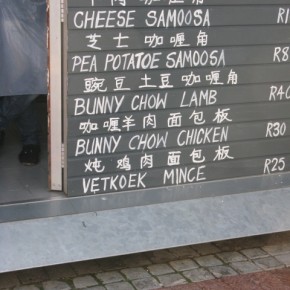
By Rachel Brown
Given my obsession with all things related to China, it was perhaps inevitable that out of all the journalists I could have turned to while visiting the Maboneng Precinct on Sunday, I would choose the one who worked for “ChinAfrica,” a magazine focused on the relationship between China and African nations. Our group had inadvertently landed ourselves on a media tour of a redeveloping district, and I had inadvertently found myself talking (yet again) about China.
As we chatted, the journalist from “ChinAfrica” mentioned that there has been a 68% growth in Chinese tourists to South Africa. I have yet to witness a mass exodus of Chinese visitors off a tour bus akin to the scenes on Old Campus, but our linguistic interactions with people in the tourism industry certainly indicate an increased Chinese presence in South Africa or at least the anticipation of a coming influx. When we boarded our South African Airways flight at JFK, two members of our group were greeted with “Ni Haos” and “Xie Xies” by crew members, and have since had similar experiences when ordering in cafes. When we disembarked from a ferry at the Victoria and Albert Waterfront in Cape Town, I was shocked to see all of the signs at food stalls written in both English and Chinese. When I asked one of the shopkeeper’s why they advertised not just “Beef Samoosas” but also “牛肉咖喱角” she explained, it’s for all the tourists – yet I didn’t see a single Mandarin speaker there.

The Sino-Africa trade relationship has grown so much that an expected surge in tourism was perhaps a natural next step. As of 2010, China was South Africa’s largest trading partner with exchange between the two nations amounting to more than $25.6 billion. From South Africa’s mineral wealth to its wine, China has become an increasingly important destination for exports, and the number of imports from China to South Africa has grown as well. South Africa has also now joined China amongst the BRICS nations and even hosted the BRICS summit in Durban this past March. Despite the distinction of rapid economic development that this designation appears to confer, South African cities don’t have the same feel of breakneck growth that I have seen in other “BRICS” nations, particularly China. South Africa’s GDP growth rate of 2.1% at the end of 2012 pales in comparison to China’s rate of 7.9% in the same period. Yellow construction cranes rise in clusters above certain parts of Johannesburg, but they are nowhere near as omnipresent as in Chinese cities, where cranes have been dubbed the new “national bird.” Even more striking is that in 2012, China’s unemployment rate was 4.1%, India’s was 3.8%, while South Africa’s was a whopping 25.2%.
Such facts lend credence to the sentiments of a cartoon I recently saw that depicted the BRICS summit in 2012. The leaders of Brazil, Russia, India, China and South Africa were seated around a negotiating table and President Zuma of South Africa was dwarfed by every other leader and situated under the heading “Briquette.” Indeed, in our interviews people seem to see South Africa not as an emerging global power, but more as a regional leader with plenty of internal problems that still need fixing. One rationale behind the inclusion of this “briquette” amongst major emerging economies was the need to have African representation in the group. But while South Africa may have had stronger financial foundations on which to develop than other African nations, countries such as Nigeria, Angola and Zambia (GDP growth rates of 6.6%, 7.4% and 7.3% respectively) and are fast catching up. Although tacking an “S” onto the end of BRIC may make the abbreviation flow nicely off the tongue, it doesn’t necessarily indicate economic accuracy. After witnessing the high rates of unemployment and significant development challenges South Africa still faces from violent crime to the education system, it seems that the “s” in BRICS may better stand for a plural noun than for South Africa.